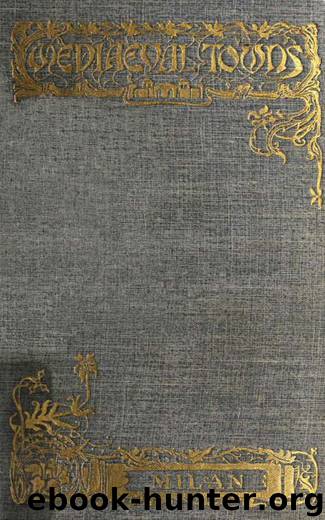The Story of Milan by Ella Noyes

Author:Ella Noyes [Noyes, Ella]
Language: eng
Format: epub
Tags: Milan (Italy) -- History, Milan (Italy) -- Description and travel
Publisher: anboco
Published: 2017-01-13T23:00:00+00:00
CHAPTER IX
Art in Milan
“Cosa bella mortal passa e non d’arte.”— Leonardo da Vinci.
The Milanese as a people do not take a great place in the story of Italian art. They show at no time the spontaneous artistic character which was the blessed birthright of the Florentines, Sienese, Umbrians, Venetians. They granted, however, splendid hospitality to the art of others. Talent of every kind was attracted to this wealthy and luxurious city, and the concourse of foreign artists roused and developed considerable industry in the natives from early times.
Lombardy, and in particular Milan, its principal city, were exposed to influences which did not reach further south. The strain of northern blood in the people, derived from their Gallic origin, readily received the impress of the ultramontanes who flowed down throughout the centuries into the fertile plains of Po and Ticino, and the thoughts and ideas which they brought, assimilating with the natural instincts of the soil, and with the ancient traditions of the Latins, resulted in an artistic character which is quite Italian, though very different from the more southern populations. It lacks their spontaneity and daring, their lofty imagination and idealism, has little of their sense of beauty, falls short in sheer ability. But it is distinguished by sincerity, a love of realism, a humble and zealous industry, and also by certain marked and inveterate mannerisms. And though the Milanese, or rather the Lombards who peopled the wide Duchy of the Visconti and Sforza, remained always very receptive, looking for a lead, and owing their strongest artistic impulses to some genius from abroad, their work keeps always its strong native character.
Milan’s greatest moment was one in her art, and in her public life. The same spirit of freedom which stood up to Barbarossa and Frederick II., raised her incomparable brick buildings of the twelfth and thirteenth centuries. In this development of architecture on the large and reasonable lines of the old Roman building, modified by the mystic ideas and melancholy sentiment of the North, and by the capabilities of the rich and plastic material yielded by the alluvial soil, Lombardy shows the highest result of the mingled elements of her artistic life. When no longer inspired by freedom, architecture was still fostered in Milan by ostentatious tyranny, and continued to be the most genial art of the people. In the fourteenth century, the Visconti raised beautiful churches and palaces, but the builders inclined more and more to abandon the national traditions for Gothic lightness and grace. In the crowning work of the Cathedral, the false Gothic ideal finally triumphed. The classical revival, which followed under the Sforza and filled the city anew with churches and palaces, was communicated to Milan by Tuscan architects. It was cherished by the eclectic spirit of princes and nobles, and owed nothing to popular impulse. But in adapting her peculiar material, brick, to the new style, Lombardy gave it a local and special character, and only when the vulgar exaggeration of the classic fashion overwhelmed Italy in a general flood of baroque extravagance, did Lombardy lose architectural individuality.
Download
This site does not store any files on its server. We only index and link to content provided by other sites. Please contact the content providers to delete copyright contents if any and email us, we'll remove relevant links or contents immediately.
Kathy Andrews Collection by Kathy Andrews(11341)
The remains of the day by Kazuo Ishiguro(8412)
Paper Towns by Green John(4808)
Spare by Prince Harry The Duke of Sussex(4802)
Industrial Automation from Scratch: A hands-on guide to using sensors, actuators, PLCs, HMIs, and SCADA to automate industrial processes by Olushola Akande(4627)
The Body: A Guide for Occupants by Bill Bryson(4591)
Machine Learning at Scale with H2O by Gregory Keys | David Whiting(3658)
Be in a Treehouse by Pete Nelson(3654)
Harry Potter and the Goblet Of Fire by J.K. Rowling(3618)
Never by Ken Follett(3547)
Goodbye Paradise(3460)
The Remains of the Day by Kazuo Ishiguro(3147)
Into Thin Air by Jon Krakauer(3134)
The Cellar by Natasha Preston(3079)
The Genius of Japanese Carpentry by Azby Brown(3043)
Fairy Tale by Stephen King(2965)
120 Days of Sodom by Marquis de Sade(2946)
Drawing Shortcuts: Developing Quick Drawing Skills Using Today's Technology by Leggitt Jim(2943)
The Man Who Died Twice by Richard Osman(2820)
